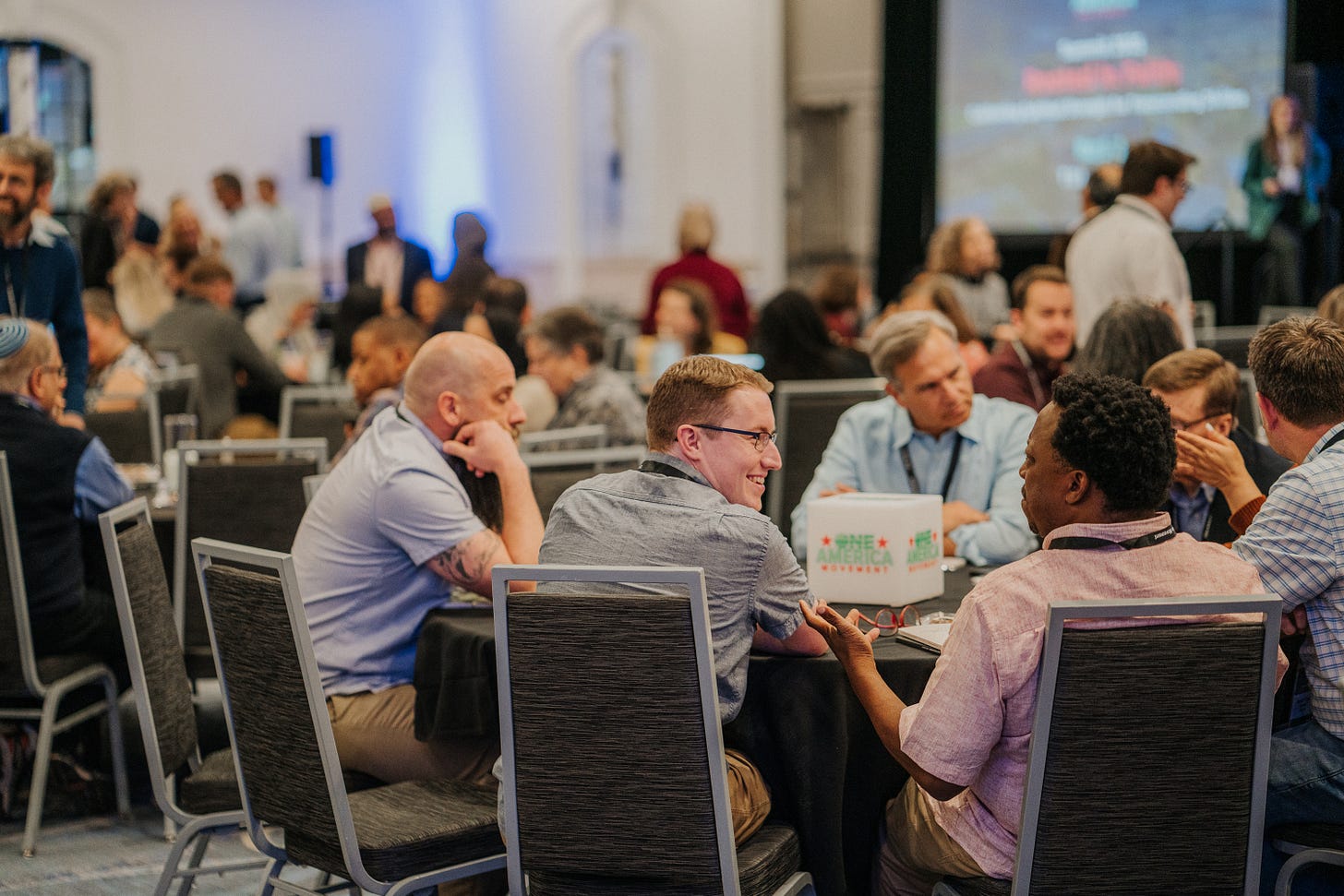Sanctifying Time
“It was only because each of us had opened ourselves up to the possibility of finding holiness in both space and time that we were able to come together in conversation.”
Close your eyes and picture the most diverse gathering you can imagine.
What do you see? People of different races and ethnicities? An interfaith group? A mix of ages and socioeconomic backgrounds?
But here’s the real question: Did you include a diversity of political beliefs?
Diversity comes in many forms. While we often embrace visible or cultural differences, it’s much harder—especially in today’s polarized world—to imagine sitting with those who hold opposing views on American society. And yet, that too is part of true diversity.
A Breakfast Table at the Summit
On the final morning of One America Movement’s annual Summit this year, I joined a breakfast table where to my left was another Reform rabbi and to my right was a Muslim man whose family is from (and still predominantly lives in) Gaza.
I am not a morning person, so an 8am pre-caffeine breakfast table is not my idea of the best setting for a hard conversation, and yet that is where I found myself. Despite my lack of caffeine, we were able to begin an intense and challenging conversation about Israel/Gaza.
We were, in large part, able to do this because One America Movement had created sacred time and space in which to open ourselves up to these interactions.
Sanctifying Time and Space
In Leviticus 23, we read:
“Adonai spoke to Moses, saying: Speak to the Israelite people and say to them: These are My fixed times, the fixed times of Adonai, which you shall proclaim as sacred occasions.”
We, as Jews, are called upon by God to take these specific times and sanctify them. God delivers the instructions, but it is on us to put these instructions into practice, thus completing the act of sanctifying time.
The sacredness of our holidays does not occur solely because God identified a specific set of dates to Moses and the Jewish people which were to become holy time. That, like any relationship, is only half of it. The other half of it—arguably the more important half—is that the Israelites follow through and actually sanctify the time.
"A Palace in Time"
Abraham Joshua Heschel, a rabbi and philosopher of the 20th century, discusses this idea of the sanctity of time and space in his book The Sabbath. He says:
“The seventh day is like a palace in time with a kingdom for all. It is not a date but an atmosphere.”
Heschel is not just talking about the sanctity of Shabbat but of all holy time, whether that is time decreed by God or time that we personally have determined to be holy.
Sanctifying time is more than the perfunctory requirements of observing a holiday. We push ourselves to be vulnerable and open our hearts and minds to new and different ways to approach creating holy time. We are intentional about the ways in which we bring our full selves to any space and time that we hope to be holy.
Imperfect, Sacred Work
The work of sanctifying space and time is deeply personal—whether it is in the context of observing Jewish holidays or combating toxic polarization. We not only have to be confident in the knowledge that we have, and in our identity, but we must be simultaneously open to the possibility of allowing ourselves to change and evolve.
This work is never perfect and never easy, but the outcomes can be so incredibly rewarding.
The conversation at that breakfast table did not end wrapped up with a pretty bow. While I cannot speak for how either of the other participants felt as our exchange concluded, I was left feeling both unsettled and also proud of the fact that we had been able to engage in a relatively calm and rational manner.
A few days after the conference, another person who was sitting across the table from us emailed me and said our discussion was “tense, remarkable, and a gift to witness.”
It was only because each of us had opened ourselves up to the possibility of finding holiness in both space and time that we were able to come together in conversation. We were able to model this for others, in the hopes that they, too, would find their own ways to seek out and create this sacred time.
This is not easy work, and it is often quite messy, but when we come together with the same purpose—the openness to allow for new possibilities of what holiness can look like—we can do hard things and work towards creating beautiful outcomes.
Shabbat Shalom.
This piece is adapted from a sermon originally given by Rabbi Wainer at Congregation Etz Chaim.

Rabbi Jessica Wainer is the Associate Rabbi at Congregation Etz Chaim of DuPage County and serves as the Chair of the Camp Council for the Union of Reform Judaism’s 6-Points Creative Arts Academy, where she is also a founding faculty member. She sits on the board of the Chicago Board of Rabbis, is a leadership team member of Religious Action Center- Illinois, and DuPage United (a Metro IAF affiliate).




